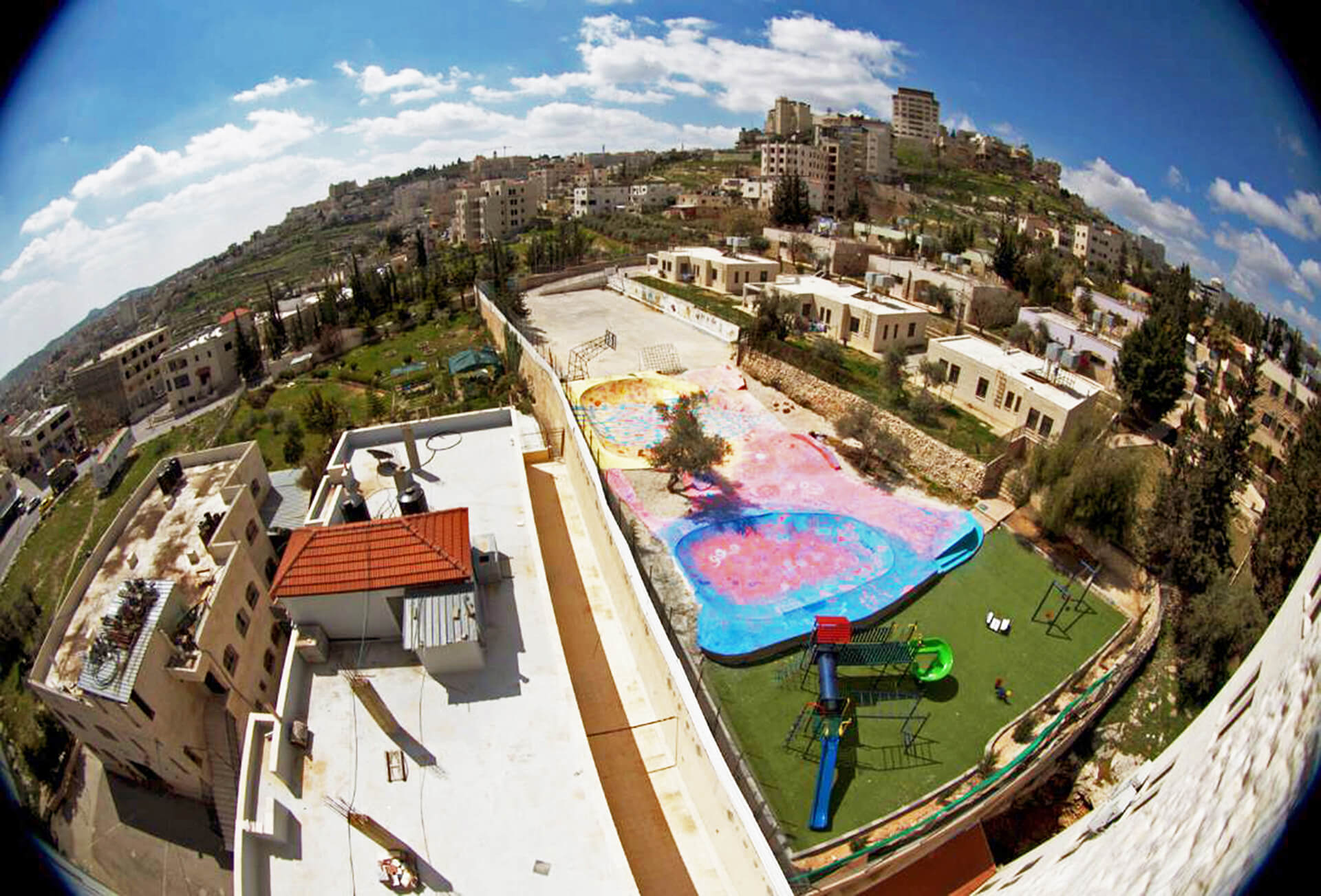A place to make friends
Bethlehem Skate Park
Situation
Bethlehem Skate Park is located at SOS Children’s Village boarding school close to the historical place Shephard´s Field in eastern Bethlehem. To accommodate for the growing number of permanent residents as well as regular visiting school kids, the management wished to expand and enhance their site. The area to the villages east at that time was a worn-out playground that was unused and therefore designated to be repurposed. In collaboration with Skate-Aid and Betonlandschaften the layout was adjusted to fit a field for ball games, traditional playground elements like slides, swings, etc. as well as a skatepark of reasonable size.
The population of Bethlehem still suffers under high poverty and unemployment rates. Around 46% of the population is living under the governmental poverty level. Most of the young people who reside at SOS Children´s Village have lost their parents through warlike conflicts or terrors. They are in need of proper education which is mostly absent in the public sector. But not only education is missing: Children need a place to hang out and spend their free time, to work off their energy, meet up with friends and make new ones.
Bethlehem Skate Park
The design goal was to make the best use of the pre-existing terrain, trees and other features to create a natural, organic flow and not interrupt the landscape by forcing a shape onto it. A nice effect of this was that use of material and labour could be kept at a minimum, which resulted in low expenses for the NGO’s. All while the required standards for skateparks still could be matched resulting in a durable construction, which is up to par with modern parks around the world. The substructure is made up from load-bearing layers of gravel, topped with reinforced concrete that is smoothened in a special treatment. This way the rolling sounds and drag on the wheels are reduced resulting in a smooth ride without obstructions or excessive noise. Still the grey concrete surface prompts somewhat unsettling associations in a city divided by a wall from the same material. The whole park was therefore finally coloured in cheerful colours mostly with the help of the children living in the village. Alongside with volunteers from both Germany and Palestine who were involved in building Bethlehem Skate Park, supervised by a representative of Betonlandschaften.
Since the sports area is on the villages property and located behind most of its infrastructure including a gatekeeper’s house, it is easy to monitor people entering and leaving. Therefore, the spot is somewhat secluded which underlines the safe-space character and general idea of the park. The children do not have to be supervised and can play in peace while still benefitting from simple and effective protection against potentially harmful outsiders. A separate maintenance entrance with a lockable gate is on street level and makes for easy car and wheelchair accessibility.
Bethlehem Skate Park also challenges the established look of a skatepark. Obviously, the park is made of concrete, but who said that it has to be grey? The Idea of the park was to give it a new look and even achieve an optical illusion by projecting two colourful images on the surface and trace them with paint. That is why the lines look straight although the area is not flat. Once coloured, the process is never over. Children want to have change in their everyday life. This is why the design of the park can be changed by kids together with their teachers. It personalizes the whole area to be exactly how the users want to have it. The possibilities to improve art and design skills of the students are endless.
PHOTOGRAPHS
Goals
With only voluntary work and under the tight budget restrictions of humanitarian aid, it was still possible to create a unique, in-situ skatepark that is well within the recognised international standards while challenging pre-existing expectations on how a skatepark is supposed to look like at the same time.
Bethlehem Skate Park was developed to increase self-confidence and corporate feeling amongst the children through sports and exercises. The new skate park was built just inside the property of the school in order to keep it as close to the children as possible. In this safe place, the children can spend their time without being influenced by the political debate and by dangers happening in Bethlehem. They can discover the world of skateboarding and learn self-reliance!
While planning and constructing the skatepark one of the most important aspects was to involve its future users in this process. As a consequence, the kids could design the area for themselves and therein gain important experience in handicraft and craftsmanship. Additionally, it increased the positive attitude towards the project. Those actions broadened young people´s skills and possibly influenced their job prospects. Having constant access to sport activities such as skateboarding can not only improve the self-confidence of children, but also give them a platform to work on their skills and experience the progress of training. Skateboarding is a very personalized sport that brings young people together at the same time.
Traditional humanitarian aid projects mainly focus on one single matter that is often addressed without considering its surrounding social system, which results in not sustainable results. A skatepark on the other hand provides a strongly empowering platform for the youngest to build upon. It enables them to change their traditional mindset on their own terms and build a better future for themselves and their country instead of telling them what to do and how to do it.
Author of text
Ralf Maier
Betonlandschaften
Photographs
Ralf Maier, Harry Gerrard, Christopher Kintrup, Samantha Robinson
Videos Skate- Aid, Harry Gerrard
VIDEOS





